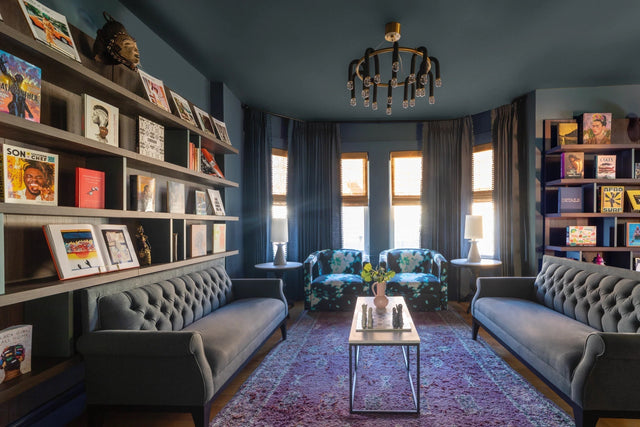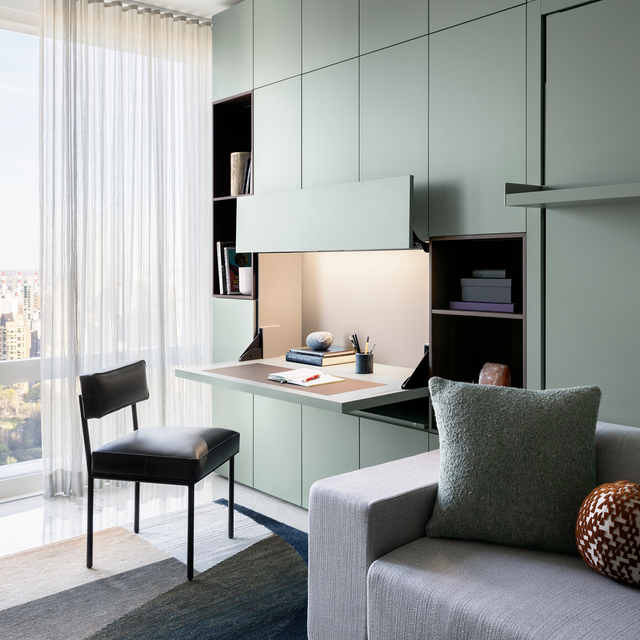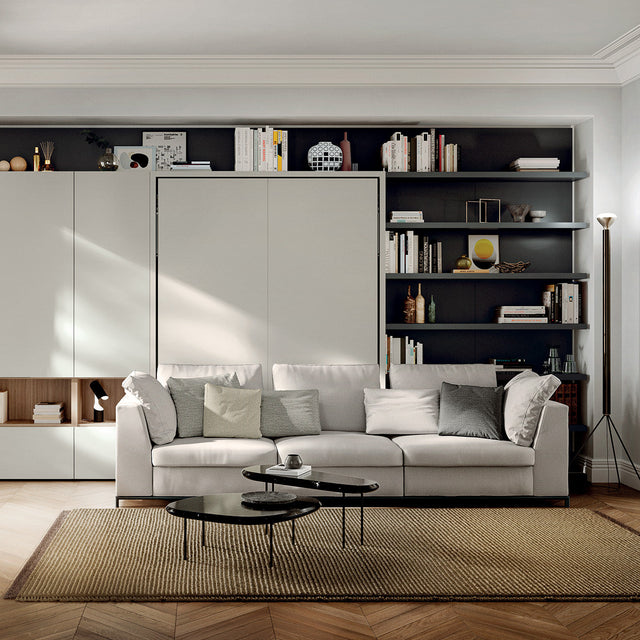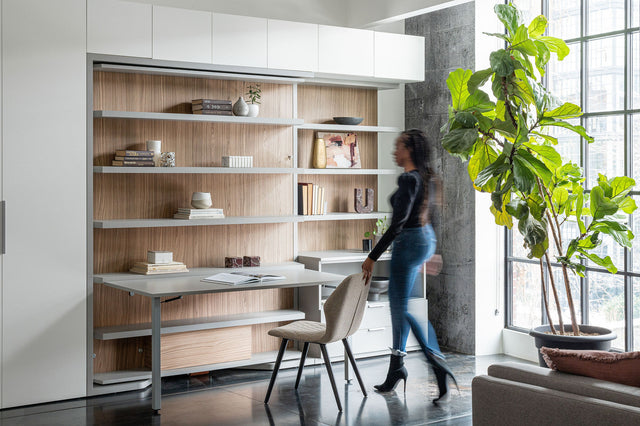More Than Books: Why Your Home Library Deserves Intention
Picture it: a cozy, book-lined room with walls decked in dark, moody wood and brass tones. A comfortable chair in the corner, gently illuminated by soft, warm light. Art pieces and personal treasures punctuate the shelves. Nearby, a drink cart holds all your favorite libations—or perhaps it’s a coffee or tea bar. Is there any greater luxury than a home library?
Much more than merely a place to store books, a personal library is a reflection of who you are: your interests, travels, routines, and quiet moments. In a world of digital everything, a tactile, analog space in your home devoted to reading and reflection is a rare pleasure.
While we might not all have the space for rolling ladder bookshelves and grand stone fireplaces, anyone can design an elevated home library. The most compelling libraries aren’t necessarily vast—they’re intentional. Whether you’re an avid book lover or an empty nester repurposing an old bedroom, the appeal of the home library lies in the ability to curate a space that feels both functional and deeply personal. A home library can even breathe new life into an underused guest room or attic, transforming it into a purposeful sanctuary.
At Resource Furniture, we’ve helped transform countless spaces into inspiring home libraries, from reimagined attic nooks to minimalist lofts.
In this article:
-
Reimagining Your Space: From Guest Room to Book Lounge
-
Designing for Mood: How to Create a Home Library Design Aesthetic
-
Planning the Layout: Flow, Function, and Flexibility
-
What Type of Shelving Suits Your Space (and Your Books)?
-
Making Room for More Than Books
-
How to Light Your Home Library
-
Choosing Furniture for Comfort, Ergonomics, and Style
-
Your Books, Your Rules: Systems for Every Kind of Reader
-
From Built-Ins to Book Walls: Library Ideas We Love
- Designing a Library That’s Uniquely Yours
Reimagining Your Space: From Guest Room to Book Lounge
Some of the most beautiful home libraries begin not with a grand room, but with a reframe: a guest room that only sees guests twice a year, an empty hallway or attic space, or an extra room whose purpose has never been clear. These underused, often overlooked areas hold enormous design potential. With some thoughtful planning, they can be transformed in a curated and considered multipurpose space. When repurposing an existing space into a multifunctional home library, be sure to assess the following:
-
Adaptability: What functions will the space serve, and how will it adapt to your needs throughout the day? Will this space act as a reading lounge by day and a family game room by night? Will it need to double as an occasional guest bedroom? Always consider function first, and let this guide your layout and furniture choices. Our multifunctional Penelope Board Wall Bed, for instance, has turned many a seldom-used spare room into a hybrid guest room/home office or home library.
-
Acoustics: Quiet is key—in a library especially. Consider how sound travels in your space and how it might affect your experience. Are there creaky floors above? Is the room adjacent to a busy kitchen or shared hallway? Soft textiles—curtains, rugs, upholstered furniture—can help absorb sound, while books themselves act as natural insulators. If the space is meant to double as a guest room or home office, acoustics become even more important for restful sleep or focused work.
-
Collection Size & Storage Needs: Think about the type and volume of your collection, and how it might grow or evolve. Is your home library housing oversized art books, slim paperbacks, vinyl records, old photographs, or a bit of everything? Custom built-in shelving creates a tailored, architectural look, while modular or adjustable systems can be easily adapted or added to over time. Consider shelving systems with display niches or integrated lighting to showcase prized possessions. If you’re short on wall space, take advantage of vertical space or storage-integrated furniture.
-
Natural Light: Natural light is a powerful asset in a home library—observe how it shifts throughout the day before committing to a layout. Morning light might lend an energizing start to a work session, while gold hour sun can make for a serene evening reading ritual. Just be mindful of potential glare, especially if you plan to be reading off a screen. UV-filtering window treatments or sheer curtains can soften brightness without sacrificing natural light.
Designing for Mood: How to Create a Home Library Design Aesthetic
Every library tells a story, not just through the books on its shelves but through the palette and materials that define the space. When exploring your library’s design aesthetic, remember that you are creating a feel, not just a look. Earthy tones like deep greens and ochres lend a sense of grounded calm; modern, paneled greige reads as subtle sophistication. Biophilic design touches—natural materials like wood grains, live edges, linens, potted plants or living walls—help create sensory depth and bring elements of the outdoors in.
Rich, moody tones and custom shelving define this eclectic library, designed for Jeanine Hays and Bryan Mason of Aphrochic.
For a case study in designing for mood, consider this dramatic home library designed for Jeanine Hays and Bryan Mason of the Brooklyn-based media and design, Aphrochic. Resource Furniture fitted this library with a custom Turati shelving system in a walnut finish, accentuated by lacquered divider panels to match the room’s deep, charcoal-teal palette. The walls, ceiling, and drapery follow a unified color treatment to blur boundaries and add drama, while allowing the furnishings, books and art to pop. Combined with the dark wood tones and layered lighting, the resulting vibe is rich, moody and sophisticated—a library that feels equal parts intellectual and creative.
When choosing your own palette and finishes, start with the mood you want to evoke. Are you drawn to comforting warm tones, or refreshing cool shades? Use color and texture as your guide—they'll help you craft a library that feels as good as it looks.
Planning the Layout: Flow, Function, and Flexibility
The best home libraries are quietly intuitive. Walkways make sense. Seating encourages pause. There’s a natural place for everything—reading, working, and hosting. A successful home library layout strikes a balance between form and function, ensuring the space adapts as your routines shift.
Start by identifying your functional zones:
-
Cozy Reading Nook: A pair of armchairs and a low table near a window can anchor a quiet corner for long afternoons with a book. Position it where natural light is abundant and traffic is minimal.
-
Shelving and Storage Areas: Map out your shelving in a way that defines space and guides the eye—for instance, a single, floor-to-ceiling book wall can serve as the visual centerpiece of the space, while a pair of bookcases flanking your desk or fireplace can create a sense of symmetry and balance.
-
Work Zone: A built-in or wall-mounted desk offers a perfect place for research or correspondence without overtaking the room. If you’re incorporating a table, be sure it suits both reading and entertaining—height-adjustable coffee-to-dining tables or expandable console tables work well for this application.
-
Guest Accommodations: A daybed or multifunctional wall bed—like our Oslo Sofa with hidden under-seat storage—provides both daytime seating and overnight sleeping space. It’s ideal for a dual-purpose room where the library must double as a guest suite.
Next, think about the overall flow of the space. Where are the high traffic areas? What views do you want to preserve from each seating position? Place key elements like seating and shelving in areas that won't obstruct walkways, block views, or crowd your designated zones.
What Type of Shelving Suits Your Space (and Your Books)?
Built-in bookshelves lend gravitas—there’s something innately comforting about a wall that has been claimed by books. The possibilities of custom shelving are endless—our Turati line, for instance, offers integrated LED accent light, open- and closed-storage options, built-in desks with wire management, hideaway flip-down bars (to pair your evening read with a nightcap!) and bronze accent grills to accentuate your decorative objects. You can even use a custom shelving unit as an elegant and functional room divider; partition a space with an L-shaped shelving configuration, or using a straight piece to fill in awkward gaps between columns.
But modular shelving systems offer flexibility that’s essential for evolving collections or changing layouts over the long-term—plus, they integrate seamlessly with other modular storage and furnishings, such as wall beds, fold-down desks, or console tables, allowing you to configure entire walls of transforming and multifunctional pieces. We often integrate pieces like our Giro into modular library systems. This transforming console pivots 90-degrees from the wall, folding out into a work or dining surface large enough to seat four. Its built-in storage options include everything from open shelving to file drawers, making it a practical choice for dual-purpose home libraries.
For renters or frequent re-arrangers, freestanding shelves deliver organization and character without the commitment.
The material of your shelves can also shift the mood: metal can feel modern, industrial, and gallery-like; rich, natural wood reads timeless and classic. Think back to the design aesthetic and overall vibe you’re trying to achieve when considering your shelf material.
Making Room for More Than Books
Books aren’t the only things worth displaying. Think of your library not just as storage, but as an opportunity to showcase a thoughtful mix of book collections and decorative objects. Curated shelves are an artful blend that reveal your personality and history.
From inherited heirlooms to ceramic pieces and framed photos, these additions lend texture and storytelling to your library. Closed storage options—drawers or cabinets at the base—help keep visual clutter at bay while maintaining a clean aesthetic. This is especially helpful for stashing unsightly necessities or rotating seasonal decor.
How to Light Your Home Library
Lighting is foundational in home library design. Beyond brightening the space or offering a handy reading light, it can completely set the tone. Start with ambient light—natural or overhead—then layer intentionally: a floor lamp beside your favorite chair to create a cozy reading nook, sconces framing a bookshelf or piece of art, LEDs tucked discreetly into a recessed channel above display shelves.
We’ve found success layering task and mood lighting when natural light is limited, as it often is in many city apartments. If your home library doubles as a workspace or guest room, lighting should shift accordingly: dimmable sconces or table lamps offer nighttime flexibility, while directional lights can support daytime reading or working. Embrace the interplay between natural and artificial light to enrich your daily rituals.
Choosing Furniture for Comfort, Ergonomics, and Style
Reading requires comfort. When selecting furniture for your home library, prioritize ergonomic seating: armchairs with supportive backs, sofas with proper depth, and upholstered benches or chaises to settle in for long stretches with your favorite book.
Include at least one table—ideally an occasional or nesting design—to perch a cup of tea, reading glasses, or laptop. If you’re designing for a dual-purpose room, choose furniture that adapts. Many clients opt for home office combinations that provide a desk by day and sleek guests at night, like the Circe Board Wall Bed. Plus, Circe offers overhead shelving that can be omitted to accommodate lower ceiling heights, making it ideal for attic or basement conversions.
Your Books, Your Rules: Systems for Every Kind of Reader
At Axiom Desert House by Turkel Design, this full-height walnut bookshelf is arranged in a colorful rainbow gradient.
There’s no wrong way to organize your personal library. Some readers sort their collection of books by author, others by genre, or even by mood. Others go with a purely visual system, organizing by spine color—controversial, yes, but undeniably elegant when done well.
Create a designated spot for your unread books—a "to-be-read" shelf that rotates seasonally can keep your selections fresh and help highlight hidden gems. Personal rituals, like adding handwritten shelf notes or using heirloom bookplates, add soul to the system and deepen your connection to your library.
From Built-Ins to Book Walls: Library Ideas We Love
Our LA showroom illustrates how modern, custom shelving can instantly elevate even the smallest library spaces.
Sometimes a single wall is all it takes. Resource Furniture’s LA showroom demonstrates how a curated shelving system can completely elevate the vibe of a room. This Turati system features ambient recessed lighting, decorative grills, and luxury finishes to elegantly display books and decor. Paired with the Penelope Sofa wall bed, WAM ottoman and height-adjusting Genie table, even this relatively small room has everything it needs to function as a multipurpose library, guest room, and living space.
A custom sliding bookcase designed by RAAD studios opens to reveal a hidden office/guest room in this NoHo duplex.
But multifunctional home libraries can take many unexpected forms: One NoHo client added a home library to their space-constrained duplex using an ingenious sliding bookshelf designed by RAAD Studios. The entire library glides to reveal a hidden office space, complete with a Penelope wall bed.
The LGM revolving wall bed is the centerpiece to this multipurpose basement remodel, doubling as a home library and guest bed.
Still others let their furnishings double as a library. In San Francisco, designer Alison Damonte reimagined a client’s basement into an all-in-one home library, guest bedroom, and teen hangout space using the LGM wall bed. By day, the LGM offers a tall bookshelf to display books and decor; at night, it revolves 180 degrees to reveal a queen bed with slide-out night stands.
Designing a Library That’s Uniquely Yours
A home library is an expression of lifestyle, taste, and intention. From cozy reading nooks to fully realized multipurpose rooms, each detail adds to the story of your space.
At Resource Furniture, we specialize in bringing these spaces to life with expert craftsmanship, multifunctional ingenuity, and timeless Italian design. If you’re ready to turn an extra room, attic space, or quiet corner into a curated sanctuary, our design team is here to help. Get in touch or visit a showroom to start your transformation.










